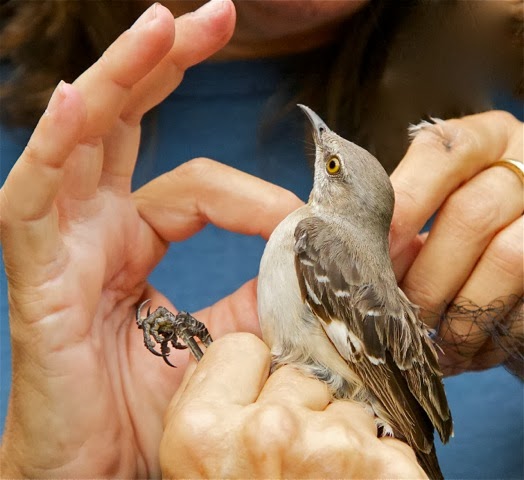In 2013 we banded a total of 270 birds that represented 39 species. In our short beginning in 2012 we only had 13 birds but 2 of those birds were species we did not catch this year.
We held 50 sessions that had newly banded birds.
Today was not a day when we added new species to the property or even any newly banded birds but it was one of my favorite sessions so far. We had an visit with Cub Scout Pack 814 and two additional Boy Scouts from Troop 811 in which we explored science in action. These young men were very interested and we talked a lot about banding. They asked very good questions too.
We did have three recaptures: a female Northern Cardinal, a Yellow-rumped Warbler, and a Gray Catbird. The Yellow-rumped Warbler had been banded in February which means it had since left to migrate north and then had made the return migration south and arrived back at Possum Long. I have seen such returns (site fidelity) with birds at feeders but I find it hard to imagine this bird finding its way back to Possum Long without having a food source as reliable as a feeder to attract it.
One scout was able to hold a bird today. I didn't feel right subjecting someone to the bite of a cardinal - that's not pleasant at all. The Yellow-rumped Warbler fit in his hand and he did a marvelous job releasing the bird. I look forward to the troop returning during spring break when more birds should be present.
Photo by Leanne LaFramboise
The Gray Catbird was banded two weeks ago and at the time we were not able to get a clear picture of the growth bars its feathers showed. Luckily we got a second chance. This bird was born this past summer and either due to mites (you can see holes in the feathers at the bottom left) or a poor food supply, the feathers grew in alternating thin and thick (and appearing darker and lighter) in places giving it a striped look. Somewhere between the time we caught it and now, it had lost the left side of its tail but there was evidence of it growing back in.
Gray Catbird
As of tomorrow all birds will be a year older - Happy New Year readers and Happy Birthday to the birds!
Next banding session will be on THURSDAY (not the regular Tuesday) January 9. Nets go up at 6:30.





















































